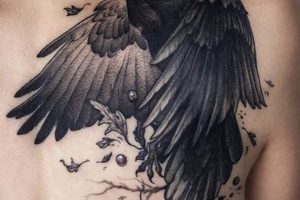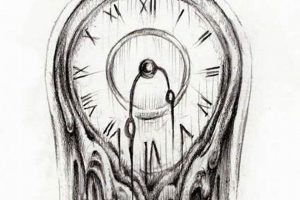Permanent ink designs worn on the ring finger offer a non-traditional alternative to conventional metal rings. These range from simple lines or Roman numerals to intricate patterns incorporating significant dates, initials, or symbols reflective of the couple’s relationship. For instance, a minimalist design might involve a thin, unbroken band, while a more complex design could weave together floral motifs or Celtic knots.
Such permanent markings symbolize commitment and offer practical advantages. They are impervious to loss or damage, ideal for individuals with active lifestyles or professions that preclude wearing traditional jewelry. Moreover, they provide an opportunity for deeply personal expression, allowing couples to create a unique symbol of their bond. While the practice is relatively modern, the concept of permanent body art signifying commitment echoes ancient traditions of using markings to denote marital status.
This exploration will delve into various design styles, practical considerations like placement and aftercare, and factors influencing design choices, such as personal aesthetics and cultural influences.
1. Design Simplicity
Design simplicity in wedding band tattoos offers a powerful statement through minimalism. A single, thin line encircling the ring finger can represent enduring commitment as effectively as a complex design. This approach prioritizes the symbolic nature of the band over elaborate aesthetics. Simple designs often age better, remaining elegant and legible over time, a crucial factor given the tattoo’s permanence. A plain band also allows for future additions or modifications if desired, providing flexibility without compromising the original design’s integrity. For example, a couple might start with a simple line and later add small elements, like birthstones or significant dates, as their relationship evolves.
Practical considerations also favor simpler designs. Intricate patterns require more detailed application, potentially increasing both the tattooing time and the associated discomfort. Furthermore, finer details are more susceptible to fading and blurring over time, particularly in an area exposed to frequent friction and handwashing. A simple, bold line, on the other hand, remains clear and distinct, requiring less frequent touch-ups. This practicality also translates to cost-effectiveness, as simpler designs typically require shorter sessions and less artist expertise.
Ultimately, design simplicity in wedding band tattoos underscores the enduring power of symbolism over elaborate ornamentation. This approach emphasizes the commitment the tattoo represents, ensuring the design’s longevity and visual impact while offering practical advantages in terms of application, maintenance, and cost. Choosing a simpler design doesn’t diminish the significance; rather, it strengthens the message by distilling it to its purest form a lasting symbol of enduring love.
2. Symbolic Representation
Symbolic representation forms the core of wedding band tattoo designs, transforming simple markings into powerful expressions of commitment and personal narratives. The choice of symbols imbues the tattoo with deeper meaning, reflecting shared values, experiences, or cultural connections. These symbols can range from traditional representations of love and eternity, such as infinity symbols or intertwined hearts, to more personalized motifs like shared hobbies, significant dates, or coordinates of a cherished location. For instance, a couple who met while traveling might incorporate a globe or a compass into their design, while music lovers might choose musical notes or lyrics from a meaningful song.
The effectiveness of symbolic representation lies in its ability to encapsulate a complex relationship within a concise visual form. Each element within the design can hold specific significance, weaving together a narrative unique to the couple. A Celtic knot, for example, can represent enduring love and interconnectedness, while Roman numerals might mark an anniversary date. Incorporating birthstones adds another layer of personalization, reflecting individual identities within the shared bond. This layered symbolism allows for a highly personalized and meaningful expression of commitment, transforming the tattoo into a permanent reminder of the couple’s shared journey.
Careful consideration of symbolic representation is crucial to ensure the design’s longevity and relevance. Selecting symbols with lasting personal significance, rather than fleeting trends, guarantees the tattoo remains a powerful emblem of the relationship for years to come. Furthermore, understanding the cultural connotations of chosen symbols is essential to avoid unintended interpretations. Thoughtful selection and placement of symbols transform a simple band into a profound statement of love and commitment, reflecting the couple’s unique bond in a permanent and deeply personal way.
3. Placement Considerations
Placement is a critical factor in wedding band tattoo design, impacting both the aesthetic and practical aspects of this permanent symbol of commitment. Careful consideration of placement ensures the tattoo remains comfortable, visually appealing, and appropriate for various social and professional contexts.
- Traditional Ring Finger Placement
The traditional ring finger of the left hand remains the most common location for wedding band tattoos. This placement aligns with long-standing cultural conventions, signifying marital status clearly and immediately. However, individuals should consider hand dominance and potential wear and tear on the tattoo due to frequent use of the dominant hand.
- Alternative Finger Placement
Alternative finger placements offer options for individuals seeking a less conventional approach. The middle finger, for instance, provides a more central and visible location, while the right-hand ring finger offers a subtle variation on tradition. Alternative placements can also accommodate existing tattoos or personal preferences regarding hand symmetry and aesthetics.
- Non-Finger Placements
For individuals seeking a more private or unconventional approach, non-finger placements offer a range of possibilities. The wrist, inner forearm, or even the side of the ring finger can provide a less visible location while still holding symbolic significance. These placements allow for larger or more complex designs and can be easily concealed or displayed as desired.
- Impact of Profession and Lifestyle
Placement choices should also consider the individual’s profession and lifestyle. Visible tattoos might be subject to dress code restrictions in certain professional settings. Individuals with active lifestyles or professions involving manual labor should consider placements less prone to friction and wear. Consulting with a tattoo artist can provide valuable insights regarding placement options best suited to individual needs and circumstances.
Ultimately, placement considerations contribute significantly to the long-term satisfaction and practicality of a wedding band tattoo. Careful evaluation of these factors ensures the chosen placement aligns with personal preferences, professional requirements, and the enduring symbolism of the commitment represented by the tattoo.
4. Pain Tolerance
Pain tolerance is a crucial factor to consider when contemplating a wedding band tattoo. The ring finger, with its delicate skin and proximity to bone, presents a higher sensitivity to pain compared to other body areas. This sensitivity can significantly impact the tattooing experience, particularly for individuals with lower pain thresholds. Understanding and preparing for potential discomfort is essential for a positive outcome.
Several factors influence individual pain perception during the tattooing process. These include the individual’s natural pain threshold, the complexity and size of the design, and the tattoo artist’s technique. Intricate designs requiring longer sessions naturally increase overall discomfort. Choosing a simpler design can minimize the duration of the procedure, thereby reducing the total pain experienced. Experienced tattoo artists skilled in efficient techniques can also contribute to a less painful experience.
Practical strategies can help manage discomfort during the procedure. Open communication with the tattoo artist about pain concerns allows them to adjust their technique and provide breaks as needed. Topical numbing creams, applied prior to the session with the artist’s consent, can offer temporary pain relief. Practicing relaxation techniques, such as deep breathing or meditation, can also help manage anxiety and discomfort. Adequate rest and hydration before the appointment contribute to a more comfortable experience. Ultimately, realistic expectations regarding pain and appropriate preparation contribute significantly to a positive and manageable tattooing experience.
5. Long-Term Commitment
The permanence of wedding band tattoos inextricably links them to the concept of long-term commitment. Choosing to mark one’s commitment in such an enduring way reflects a profound intention for lifelong partnership. This decision requires careful consideration, mirroring the gravity of the marital vows themselves. Unlike traditional rings, easily removed or replaced, a tattoo represents a deliberate and lasting declaration of love and fidelity. This permanence can serve as a powerful reminder of the commitment made, reinforcing the bond during challenging times. For example, a couple facing difficulties might look at their matching tattoos as a symbol of their enduring promise, encouraging them to work through their issues.
The decision to get wedding band tattoos should be a mutual one, reached through open and honest communication. Couples should discuss their motivations, expectations, and any potential concerns before undertaking this permanent expression of their commitment. Considering the potential impact on future careers or changing personal aesthetics is crucial. While tattoo removal is possible, it’s a costly and time-consuming process. Therefore, a thorough understanding of the implications of permanence is essential for ensuring the tattoo remains a positive symbol of the relationship rather than a source of regret. Engaging in pre-tattoo counseling, similar to pre-marital counseling, can facilitate these crucial conversations and contribute to a more informed and thoughtful decision-making process.
In conclusion, the connection between wedding band tattoos and long-term commitment is undeniable. The inherent permanence of the tattoo underscores the profound nature of the marital bond. Thoughtful consideration, open communication, and a realistic understanding of the implications are crucial for ensuring the tattoo remains a cherished symbol of enduring love and commitment throughout the couple’s journey together. This permanence, while daunting for some, offers a potent reminder of the promises made and the enduring strength of the relationship.
Tips for Choosing Wedding Band Tattoos
Selecting appropriate wedding band tattoos requires careful consideration of various factors to ensure the designs reflect the couple’s unique bond and stand the test of time. The following tips provide guidance for navigating this important decision.
Tip 1: Research Tattoo Artists Thoroughly: Expertise in fine linework and experience with tattooing fingers are crucial. Examine portfolios for examples of previous wedding band tattoos and assess the artist’s style and precision. A skilled artist understands the unique challenges of finger tattoos, such as ink migration and fading.
Tip 2: Consider Lifestyle and Profession: Certain professions may have restrictions on visible tattoos. Individuals with active lifestyles or frequent handwashing should choose durable designs and placements less prone to wear and tear. Hypoallergenic inks can minimize potential skin reactions for those with sensitivities.
Tip 3: Explore Diverse Design Options: Beyond simple bands, explore options like Roman numerals, Celtic knots, geometric patterns, or incorporating birthstones or significant dates. Consider the overall aesthetic and ensure the chosen design harmonizes with existing tattoos, if any.
Tip 4: Prioritize Quality Aftercare: Proper aftercare is crucial for preserving the vibrancy and longevity of the tattoo. Follow the artist’s instructions diligently, which typically include keeping the tattoo clean and moisturized and avoiding excessive sun exposure or soaking.
Tip 5: Reflect on Symbolic Meaning: Infuse the design with personal significance by incorporating elements reflecting shared values, hobbies, or important dates. Meaningful symbols enhance the emotional connection to the tattoos and reinforce the commitment they represent. For instance, incorporating a shared love for nature could be represented by a delicate leaf or vine design.
Tip 6: Discuss Expectations and Budget: Open communication between partners regarding design preferences, placement, and budget is essential. Tattoo costs vary based on complexity, size, and artist experience. Establishing a clear budget beforehand helps manage expectations and ensures alignment between partners.
Tip 7: Plan for Touch-Ups: Finger tattoos are more susceptible to fading due to frequent use and exposure. Be prepared for occasional touch-ups to maintain the design’s clarity and vibrancy over time. Discuss touch-up policies and costs with the chosen artist.
By carefully considering these tips, couples can make informed decisions, ensuring their wedding band tattoos serve as beautiful and enduring symbols of their commitment.
The subsequent conclusion will summarize the key aspects of choosing wedding band tattoos and emphasize their significance as lasting expressions of love and partnership.
Frequently Asked Questions about Wedding Band Tattoos
This section addresses common inquiries regarding wedding band tattoos, offering factual information and practical guidance for those considering this permanent symbol of commitment.
Question 1: How long do wedding band tattoos typically last?
While theoretically permanent, their longevity depends on factors like placement, ink quality, aftercare, and individual skin characteristics. Finger tattoos, due to frequent use and exposure, may require more frequent touch-ups compared to tattoos in other locations. Proper aftercare is crucial for maximizing longevity.
Question 2: Are wedding band tattoos painful?
The ring finger area tends to be more sensitive due to thin skin and proximity to bone. Pain levels vary based on individual pain thresholds, design complexity, and artist technique. Consultations with tattoo artists allow for discussions about pain management strategies.
Question 3: What are the costs associated with wedding band tattoos?
Costs depend on factors such as design intricacy, size, artist experience, and geographic location. Simpler designs typically cost less than elaborate ones. Obtaining quotes from multiple reputable artists allows for informed budget decisions.
Question 4: Can wedding band tattoos be removed?
Removal is possible through laser treatments, but complete removal is not always guaranteed, and the process can be costly, time-consuming, and potentially painful. Careful consideration of design choices is paramount due to the permanence of tattoos.
Question 5: What design options are available for wedding band tattoos?
Numerous design options exist, ranging from simple bands to intricate patterns incorporating symbols, dates, or initials. Inspiration can be drawn from various sources, such as Celtic knots, Roman numerals, geometric designs, or personalized motifs reflecting shared interests.
Question 6: What are the potential risks or downsides of wedding band tattoos?
Risks include infection if proper aftercare is not followed, allergic reactions to ink, fading or blurring over time, and potential regret if the relationship dissolves. Thorough research and careful consideration of the long-term implications are crucial.
Careful consideration of these frequently asked questions provides a more informed perspective on wedding band tattoos, facilitating thoughtful decision-making aligned with individual circumstances and expectations.
The following conclusion summarizes the key considerations and benefits of choosing wedding band tattoos as a permanent symbol of commitment.
Conclusion
Wedding band tattoos offer a powerful, permanent alternative to traditional rings, symbolizing commitment through personalized designs. Careful consideration of design simplicity, symbolic representation, placement, pain tolerance, and long-term commitment ensures a meaningful and enduring symbol. Practical aspects, including artist selection, aftercare, and potential touch-ups, contribute to the tattoo’s longevity and aesthetic appeal. Addressing common concerns regarding permanence, pain, and cost empowers informed decision-making.
Wedding band tattoos represent a profound declaration of love and partnership, etched not just onto skin but into the very fabric of a shared journey. This enduring mark serves as a constant reminder of the promises made and the strength of the bond, offering a unique and deeply personal expression of lifelong commitment.







